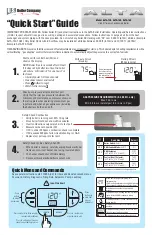
X. Modular installation (continued)
G.
Modular Boiler Operating Information
1. Major Features
a.
“Plug & Go” Multiple Boiler Control Sequencer
When multiple boilers are installed, the Sage2.1’s
Sequencer may be used to coordinate and
optimize the operation of up to eight (8) boilers.
Boilers are connected into a “network” by simply
“plugging in” standard ethernet cables into each
boiler’s “Boiler-To-Boiler Communication” RJ45
connection.
b.
Sequencer Master
A single Sage2.1 Control is parameter selected
to be the Sequencer Master. The call for heat,
outdoor and header sensors, and common pumps
are wired to the Sequencer Master “enabled”
Sage2.1 Controller.
c.
Improved Availability
The following Sage2.1 features help improve the
heat availability:
i.
Backup Header Sensor: In the event of a
header sensor failure the lead boiler’s supply
sensor is used by the Sequence Master
to control firing rate. This feature allows
continued coordinated sequencer control even
after a header sensor failure.
ii.
“Stand Alone” Operation Upon Sequence
Master Failure: If the Sequence Master
Sage2.1 Control is powered down or
disabled or if communication is lost between
boilers, individual boilers may be setup to
automatically resume control as a “stand
alone” boiler.
iii.
Slave Boiler Rate Adjustment: Each slave
boiler continues to monitor supply, return
and flue gas temperatures and modifies the
Sequence Master’s firing rate demand to
help avoid individual boiler faults, minimize
boiler cycling and provide heat to the building
efficiently.
iv.
Slave Boiler Status Monitoring: The Sequence
Master monitors slave boiler lockout status
and automatically skip over disabled boilers
when starting a new slave boiler.
d.
Lead/Slave Sequencing & Equalized Run Time
One boiler is a “Lead” boiler and the remaining
networked boilers are “Slaves”. When demand is
increasing, the Lead boiler is the first to start and
the Slave boilers are started in sequential order
(1,2,3,…) until the demand is satisfied. When
demand is decreasing, the boilers are stopped in
reverse order with the Lead boiler stopped last
(…,3,2,1). To equalize the run time the sequencer
automatically rotates the Lead boiler after 24 hours
of run time.
e.
Customized Sequences
Normally, boilers are started and stopped in
numerical order. However, custom sequences
may be established to optimize the heat delivery.
For example, in order to minimize boiler cycling,
a large boiler may be selected to run first during
winter months and then selected to run last for
the remainder of the year. Refer to Paragraph G,
4 “Slave Selection Order” for more information.
f.
Multiple Demands
The Sequence Master responds to Central Heat,
DHW and frost protection demands similar to the
stand alone boiler (refer to Operation Section XII,
Paragraph A, 7 ”Priority Demand” for additional
information).
g.
Shared or Isolated DHW Demand
When the Indirect Water Heater (IWH) parameter
is set to “Primary Piped” the Sequence Master
sequences all required boilers to satisfy the DHW
setpoint (default 180 F). When “Boiler Piped” is
selected only the individual slave boiler, with the
wired DHW demand and pump, fires to satisfy
the DHW setpoint.
h.
DHW Two boiler Start
When the Indirect Water Heater (IWH) parameter
is set to “Primary Piped” and the DHW Two
Boiler Start parameter is set to “Enabled” two
boilers are started without delay in response to
a DHW call for heat. This feature allows rapid
recovery of large IWH’s and multiple IWH’s.
i.
Optimized Boiler Modulation
Boiler firing rate is managed to increase smoothly
as boilers are started. For example, when a
second boiler is started the initial firing rate is
100%/2 or 50%, when the third boiler is started
the firing rate starts at 200%/3 or 66%. After
the initial start, the Sequence Master develops a
unison firing rate demand based on it’s setpoint
and sensed header temperature.
j.
Innovative Condensing Boiler Control
During low loads, the Sequence Master limits
firing rates to a ‘High Fire Limit” to ensure peak
operating efficiency. Lower firing rates boost
efficiency by helping increase the amount of
flue gas water vapor condensation. The Sage2.1
maintains a “High Fire Limit” until the last lag
boiler is started. At this point, the “High Fire
Limit” is released to allow boilers to modulated
as required to meet heat load. Refer to Figures
45A and 45B for additional information.
Содержание Alpine ALP080
Страница 40: ...40 Figure 29 Condensate Trap and Drain Line V Condensate Disposal continued ...
Страница 56: ...56 VIII Electrical continued ...
Страница 57: ...57 VIII Electrical continued Figure 35 Wiring Connections Diagram ...
Страница 58: ...58 Figure 36 Ladder Diagram VIII Electrical continued ...
Страница 64: ...64 Figure 39 Modular Boiler Direct Vent Termination X Modular Installation continued ...
Страница 65: ...65 Figure 40 Modular Boiler Concentric Vent Termination X Modular Installation continued ...
Страница 131: ...131 SERVICE RECORD DATE SERVICE PERFORMED ...
















































